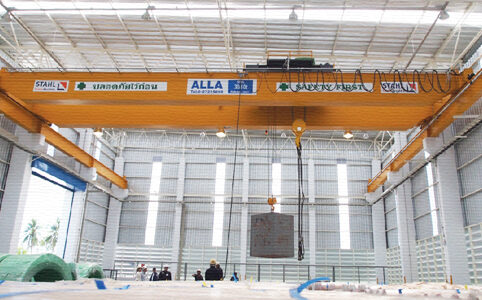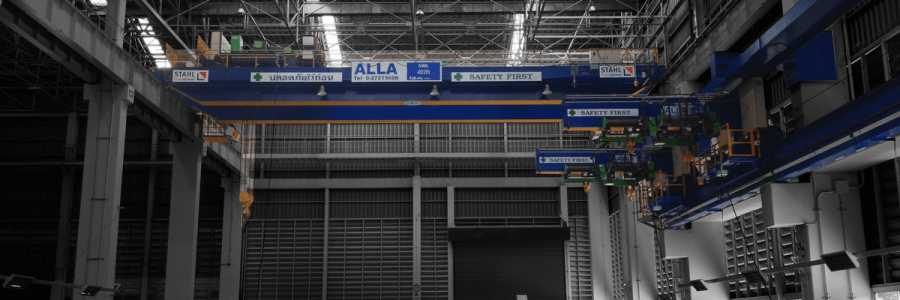CRANE

Hoists and cranes
Hoists and cranes are equipment that facilitate the safe and convenient movement of heavy objects. Our experienced team is able to design them to suit the application and conditions of each site for maximum efficiency and compliance with international standards.
ALLA is currently a market leader in hoists and cranes. Our team has over 30 years of experience in design, assembly, and installation. Engineers oversee every step of the manufacturing process, and we are constantly improving our processes.
Our Partners
![]()

Overhead Crane
Single Girder and Double Girder Types
Overhead cranes are the most popular cranes because of their simple design, easy installation, and simple operation. They can be used with either chain hoists or wire rope hoists, depending on the desired lifting weight. Single girder cranes should be installed in buildings with a width of no more than 24 meters and a lifting weight of no more than 16 tons. For buildings with wider widths, double girder cranes are more suitable. The ALLA hoisting equipment can be designed to have two sets of hoists on the same trolley drive to lift equipment that requires turning workpieces.

Suspension Crane
It is a crane that is hung from a rail, similar to an overhead crane (Overhead Crane), where the girder is attached and hung from the wheel beam set (End Carriage). The components of an overhead crane under the running rail (Suspension Crane) are the same as an overhead crane. It can be designed as both a single girder (Single Girder) and double girder (Double Girder) according to the lifting weight and width, and has a standard safety equipment system as well.

Gantry Crane
This type of crane is usually installed in an outdoor area. The crane leg structure supports the girder set on both sides for Gantry Crane or on one side for Semi-Gantry Crane. The entire crane set runs on rails which are installed on the floor. The equipment on the crane set is the same as overhead cranes and has the same standard protection system.

Pillar Jib Crane
This type of crane is mounted on a column attached to the building floor. Its outriggers can be extended and rotated at specified angles. It can lift capacities from 0.25 tons to 10 tons, depending on the outrigger reach and the height of the lift.
This type of crane has limited space, so it must be used in specific areas where it is not mobile. It can be designed with an electric drive system or a manual drive system for smaller cranes.

Wall Jib Crane
This type of crane is mounted on a building column, with an arm that can be extended and rotated at specified angles. It can lift capacities from 0.25 tons to 10 tons, depending on the arm span. The building column should be designed to safely support the crane’s load, in accordance with engineering standards.
This type of crane is similar to a jib-type column-mounting crane, which is limited in space and should be used in specific areas without movement. It can be designed with either an electric or manual drive system, and it comes with standard safety equipment and the same safety features as a jib-type column-mounting crane.

Wall Travelling Crane
This crane has an arm extending from the wall at a specified distance, but not exceeding 10 meters. The longitudinal drive system includes an end carriage and a gear motor, enabling the crane to run on rails.
This type of crane has limited space and is mounted on a building wall. Therefore, it must be used in confined spaces and can only be used within the crane’s running area.
ALLA is the market leader in the hoist and crane product segment.




Why choose a crane from ALLA?
✅ Engineers and technicians specializing in industrial cranes
✅ Uses strong, internationally standardized structural materials
✅ Supports loads from 100 kg to hundreds of tons
✅ Inspection and safety certification services
✅ After-sales service, spare parts, and comprehensive maintenance
Let us help you choose the right crane for you.
Contact ALLA’s team of experts for consultation, design of the right crane system for your job, free quotation and complete installation service.

